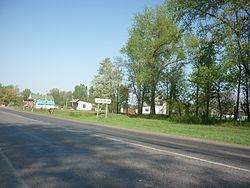Time zone EET (UTC+2) Postal code 20040 | Area code +380 4745 | |
 | ||
Ivanhorod or Ivangorod (Ukrainian: Іванго́род, Russian: Ивангород, Polish: Iwangród) is a village located in the Khrystynivka Raion of the Cherkasy Oblast (province) in central Ukraine, some 151 kilometres (94 mi) from Kiev.
Contents
Map of Ivanhorod, Cherkasy Oblast, Ukraine
History
The first traces of a settlement date back to prehistoric times, with archeological findings from the Cucuteni-Trypillian culture. In the Middle Ages Ivanhorod lay on the Chumak trade road from Kiev to Crimea. From the 13th century on, it was part of the Grand Duchy of Lithuania and subsequently, until 1791, the Polish–Lithuanian Commonwealth. The village (from 1609 owned by the Kalinowski family) lay on the path of the Khmelnytsky Uprising. After the Second Partition of Poland Iwanogród became part of the Russian Empire.
The Jewish community in Ivanhorod dates back to early 19th century. In 1897, the Jewish population was 442 people. During the Holocaust (on what is now Ukrainian territory), a mass murder was committed by the German Einsatzgruppe in the southern part of Ivanhorod (1942) with an unknown number of victims.
The executions
A wartime photograph showing a mother and child shot in cold blood outside the village by a German SS soldier is now considered, in the words of British journalist Robert Fisk, "one of the most impressive and persuasive images of the Nazi Holocaust." It was featured in numerous books, and at photo-exhibits both in Poland and Germany, as "precious and terrible evidence" of "the Nazi cruelties in Eastern Europe."
The photograph was originally sent from the Eastern Front to Nazi Germany, but intercepted at the Warsaw post office by members of the Polish resistance, the Home Army, for Jerzy Tomaszewski who documented Nazi war crimes for the Polish government-in-exile. On the reverse, it was inscribed: "Ukraine 1942 - Judenaktion in Iwangorod" (English: Ukraine 1942 - Jewish operation in Ivanhorod). The executioner appears to be standing over the body of an already executed person. The gun barrels of other executioners are visible at the left-hand edge of the photograph. In 1964, at the height of the Cold War, the popular German weekly Der Spiegel (Nr. 49/1964) published the photograph along with a diatribe naming several angry readers claiming it to be a fake generated by the Russians, although the most incriminating evidence came from the official German records. Confronting a society with photographic evidence of one's own personal experience of war is almost as old as photography itself, wrote reporter-turned-historian Janina Struk, who discussed this image in her Private Pictures: A Soldiers' Inside View of War. In extreme situations the "possession of such private pictures could lead to a court martial", and yet soldiers keep taking them.
Economy
As of 2013, Ivanhorod had 504 employed residents, with the main economic activity being agriculture. There is a school in the village, a library with 18,000 books, a medical clinic with 9 employees, pharmacy, a post office, a bank, and several large farms.
